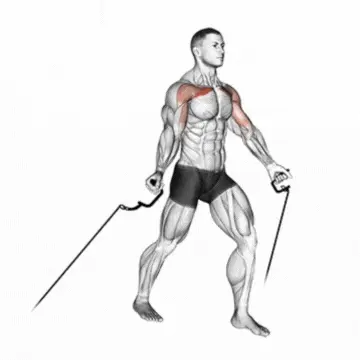Low Cable Crossover For Chest: Form, Faults, 10 Benefits
A low cable crossover is an exercise that targets the upper chest muscles. To perform this exercise, attach the handles of the cable machine to the lowest position and stand in the center of the machine with one foot in front of the other.

Then, grasp the handles with an underhand grip and bring them up and across the body in a sweeping motion, squeezing the chest muscles at the top of the movement. This exercise allows for a greater range of motion and a more natural movement pattern than traditional chest exercises, such as bench press. By targeting the upper chest muscles, the low cable crossover can help to develop a more defined and aesthetically pleasing chest.
Low Cable Crossovers: A Comprehensive Guide to Building a Stronger Chest
The chest is one of the most prominent muscles in the upper body and an important aspect of overall physical fitness. If you’re looking to build a strong and toned chest, incorporating low cable crossovers into your workout routine is a great place to start.
This exercise targets the chest, triceps, and shoulders, making it an excellent multi-joint exercise for building overall upper body strength. Additionally, low cable crossovers can help improve posture and increase flexibility in the shoulders and chest.
Here’s a step-by-step guide on how to properly perform low cable crossovers, as well as 10 benefits of this exercise for a stronger chest:
How to Do Low Cable Crossovers
- Start by selecting a low cable pulley machine and adjusting the cable height to waist level.
- Stand facing the machine with your feet shoulder-width apart and knees slightly bent.
- Grasp one cable in each hand and extend your arms straight out in front of you.
- Slowly cross your arms in front of your body, keeping your arms straight, until your hands meet in front of your chest.
- Hold for a brief moment and then return to the starting position.
- Repeat for the desired number of reps.
There are a few common faults that may occur while performing low cable crossovers for upper chest:
Rounding the shoulders: This is a common mistake where the shoulders are pulled forward during the exercise. This can lead to poor form and decreased effectiveness of the exercise. To avoid this, keep the shoulders down and back throughout the movement.
Arching the back: Arching the back during the exercise can cause strain on the lower back and reduce the effectiveness of the exercise. To avoid this, engage your core muscles and maintain a neutral spine throughout the movement.
Bending the elbows too much: Bending the elbows too much can shift the focus away from the chest muscles and onto the arms. To avoid this, keep the elbows slightly bent and focus on using the chest muscles to move the handles.
Lifting too much weight: Using too much weight can compromise form and increase the risk of injury. Start with a lighter weight and gradually increase the resistance as you become stronger.
To avoid these faults, focus on maintaining proper form throughout the exercise and start with a weight that is appropriate for your fitness level. It’s also a good idea to have a trainer or workout partner observe your form to help correct any faults.
10 Benefits of Low Cable Crossovers
- Strengthens the chest muscles
- Targets the triceps and shoulders
- Improves posture
- Increases flexibility in the shoulders and chest
- Can be done with a variety of weights for versatility
- Easy to learn and perform
- Can be done with or without weights
- Can be done at home or at the gym
- Improves stability and coordination
- Helps prevent injury
It’s important to remember that proper form is crucial when performing low cable crossovers. Make sure to keep your back straight, your core engaged, and your elbows slightly bent throughout the exercise.
Incorporating low cable crossovers into your workout routine can help you build a stronger and more toned chest. Whether you’re a beginner or a seasoned fitness enthusiast, this exercise is a great addition to your upper body workout routine.
So if you’re looking to take your chest and upper body strength to the next level, give low cable crossovers a try and experience the benefits for yourself!
What muscles does Low Cable Crossovers work?
Low cable crossover is an effective exercise for targeting the upper chest muscles. The following muscles are primarily worked during this exercise:
Upper chest (clavicular head of the pectoralis major): The sweeping motion of the handles targets the upper portion of the chest muscle, helping to create a more defined and aesthetically pleasing chest.
Anterior deltoids: As you raise your arms across your body, the front of your shoulders also work to stabilize and support the movement.
Triceps: Your triceps work to extend your arms as you bring the handles back to the starting position.
Serratus anterior: This muscle, located on the side of the chest, is activated as you bring the handles across your body.
By engaging these muscles, the low cable crossover helps to strengthen and tone the upper body, improving overall upper body strength and aesthetics.
Follow Learn For Fit For learn more.

